|

|
|
|
What Happened to Mother Earth?
BY: MAYESVARA DASA
Feb 25, 2021 — IRELAND (SUN) — Part One.
Srila Prabhupada used the term ‘impersonalism’ to describe the pseudo-spiritual ideology which denies the idea of God having an eternal form, personality, abode, activities, associates, etc. Srila Prabhupada referred to impersonalism as ‘another type of atheism’, and ‘a calamity for the spiritualists’. In this paper we shall show how the seemingly innocuous idea that the Earth is a globe floating in space actually creates ‘impersonalism’, ‘atheism’, and ‘calamity’ in our understanding of Sri Krishna, as well as in our understanding of Sri Krishna’s avatars (such as Varaha who lifts the Earth, and Ananta-sesha who holds the Earth). We shall also show how the globe creates impersonalism in our understanding of Sri Krishna’s creation, particularly with regards to our understanding of the true shape, size, and purpose of the Earth, as well as our understanding of the personified deity of the Earth, namely Bhu-devi.
In the following papers we shall look at a number of Indian paintings spanning several centuries which show a dramatic transformation from traditional depictions of the Earth as a flat-Earth presided over by the Goddess Bhuh (Mother Earth), to the 20th century portrayal of what Sumathi Ramaswamy referred to as ‘an impersonal spherical globe rather than a sentient being’. Sumathi Ramaswamy is the author of Terrestrial Lessons, an academic book of great merit that records the history of the introduction of the globe into India by Western powers. We shall return to this book later.
THE GODDESS OF THE EARTH
According to the Vedic teachings the Earth is not only a physical landscape, she is also a sentient being with a charming and beautiful form and personality. The Earth-shakti (Bhuh) is in fact one of the wives of Lord Vishnu who resides eternally in Vaikuntha. The Padma Purana describes Bhu-devi sitting at the right side of Vishnu:
"Therefore, having muttered the very pious, auspicious formula of eight syllables, he obtains Vishnu's world, giving all desired objects. The glorious Vishnu, seated on the jewelled couch (bright) like the rays of a thousand suns, (placed) in a divine hall, shone. The glorious Vishnu is seated on a divine lotus-seat, (placed on) a divine golden seat, which is held by Saktis supporting it, which is full of many jewels, which has many colours; the seat is on the eight-petalled lotus, auspicious like the eight letters of the formula, having the auspicious mystical letter of Laksmi, and having the lustre like that of crores of young suns. To his right side is the world's mother, Hiranmayi (full of gold). She is holding the divine chowries. She is adorned with divine garlands. With her hands she has held a pot of jewels, a citron, and a golden lotus. To his right is goddess Prthivi (the Earth), bright like the petals of a blue lotus. She is having various ornaments and is adorned with beautiful garments. In her upper hands she has held a couple of beautiful red lotuses. With the other two hands the goddess has held a couple of vessels of corn." (Padma Purana, Vl.229. 67-80)
Bhu-shakti resides with Vishnu in Vaikuntha and repeatedly manifests the physical form of Bhu-mandala within each of the innumerable universes as they undergo perpetual cycles of creation, maintenance, and destruction. Although the physical landscape of the Earth is sometimes manifest and sometimes not manifest, Bhu-shakti is eternal, and the Bhu-mandala is the archetype which appears again and again in each universe:
"Sri Narayana said, O Narada! So it is heard that the Earth appears at the very outset of the creation. Her appearance and disappearance so occur in all the Pralayas. (This Earth) the manifestation of the great Shakti, sometimes becomes manifest in Her and sometimes remains latent in Her (the Shakti). It is all the will of that Great Shakti...
There is this Earth (world) in every universe; and along with her, there are mountains, forests, seven oceans, seven islands, Sumeru mountain, the Moon, the Sun and other planets, Brahmaloka, Visnuloka (the abode of Visnu) Sivaloka and the regions of the other Devas, sacred places of pilgrimage, the holy land of Bharatavarsa, the Kanchani Bhumi, seven heavens, seven Patalas or nether regions, on the above Brahmaloka, and Dhruvaloka. This law holds good in every world in every universe. So every universe is the work of Maya and thus it is transient. At the dissolution of Prakriti, Brahma falls. Again when creation takes place, the Maha Virat appears from Sri Krisna, the Supreme Spirit. Eternal is this flow of creation, preservation and destruction; eternal is this flow of time, Kastha; eternal is this flow of Brahma, Vishnu and Mahesa, etc. And eternal is this flow of Vasundhara who is worshipped in the Varaha Kalpa by the Suras, Munis, Vipras, Gandarbhas, etc. The Sruti says that the Presiding Deity of this eternal Earth is the wife of Visnu in His boar-form." (Devi Purana, Canto Nine, chapter 9, verses 5-23; c.f. Brahma-Vivarta Purana, Prakriti Khanda, chapter 8)
In Their form as Bhu-Varaha, Vishnu and Bhu-devi live in Uttara-kuru varsha which on the northern side of Jambudvipa. This is described in the Fifth Canto of Srimad Bhagavatam by Sukadeva Goswami:
"Sukadeva Gosvami said: Dear King, the Supreme Lord in His boar incarnation, who accepts all sacrificial offerings, lives in the northern part of Jambudvipa. There, in the tract of land known as Uttarakuru-varsha, Mother Earth and all the other inhabitants worship Him with unfailing devotional service by repeatedly chanting the following Upanishad mantra." (5.18.34)
The above below shows Jambudvipa divided into nine varshas (regions), and each varsha is home to a different avatar of Krishna. Nara-Narayana live in Bharata-varsha, and Bhu-Varaha live at the opposite side of Jambudvipa in Uttara-kuru varsha.

Though we live on the same tract of land as the Earth goddess, we are separated by a distance of many yojanas (the distance between the southern coast of Bharata-varsha and the northern coast of Uttara-kuru-varsha is 100,000yojanas or 800,000 miles). The Skanda Purana narrates an occasion when Narada Muni received dharshan (vision) of Sri Sri Bhu-Varaha, as the Lord was being worshiped by devas and great rishis.
"Vyasa said: Formerly, in the divine Yuga, O Suta, Narada, the most excellent one among sages, went to the peak of Sumeru which is extremely resplendent on account of different kinds of gems and jewels. In its middle he saw the vast and divinely brilliant abode of Brahma. In the region to the north of it he saw an excellent Pippala tree (holy fig tree). It was a thousand Yojanas high and twice that in extent. At its root he saw a heavenly Mandapa (hall) equipped (i.e. decked) with different kinds of gems and jewels. It was adorned with thousands of ruby-columns. There were clusters of necklaces of Svastika design made of lapis lazuli, pearls and other jewels. It was rendered splendid by means of divine Toranas (‘ornamental arched doorways’). There were many kinds of birds and animals made of splendid gems and jewels of all the nine kinds. It had a big entrance made of topaz. The Gopura (the minaret or a lofty towered gate at the gateway) had seven storeys. It was rendered splendid by means of two panels of doors made of brilliant diamonds.
After entering it he saw a divine pearl-set platform within. The great sage climbed on to the lofty dais set with lapis lazuli. In its middle he saw an exceedingly lustrous throne that was unequalled (in workmanship) and very high. It had eight brilliant legs and was studded with pearls. In its middle there was a divine lotus lovely and splendid with a thousand petals. It was white and resembled a thousand moons in beauty and splendour. It sparkled exceedingly with its pericarp and filaments. In its middle he saw a beautiful being in the form of a man as huge as the Kailasa mountain. He had a brilliance of ten thousand full moons. He was seated within the lotus. He had four arms and highly magnificent limbs. He had the splendid face of a boar. The excellent Purusha had a conch and a discus (in two hands) and held (the other two) in gestures of granting boons and immunity from fear. He wore yellow garments. The Lord with long eyes resembling lotuses had a gentle face resembling the full moon. His lotus-like face had the fragrance of incense.
The sound of Saman hymns issued from him. He was an embodiment of Yagnas. The wooden sacrificial ladle (sruc) constituted his snout. The sruva (ladle) was his nose. He resembled the Milk Ocean. A crown enhanced the brilliant splendour of his face. He had the Srivatsa mark on his chest. He shone with a splendid white sacred thread. His strong and broad chest projected forward shining brightly with the splendour of the Kaustubha jewel. He was bedecked in divine ornaments of gold studded with excellent gems and jewels. He was as sparkling as the autumnal cloud overspread with clusters of lightning streaks.
With the sole of his left foot placed on a footstool he constantly shone brilliantly with ornaments like bangles, armlets, bracelets and ear-rings. Day and night, he was attended upon by Brahma and the leading sages, Vasistha, Atri, Markandeya, Bhrgu, and many others. He was served and attended upon by Indra and other Guardians of the Quarters and groups of Gandharvas and celestial damsels. Narada bowed down to the Lord of Devas and approached him. He eulogized Dharadhara (‘the Uplifter of the Earth’) with excellent passages from the Upanishads. Extremely delighted Narada stood near the Lord.
[The Arrival of Goddess Earth to the Presence of Varaha]:—
In the meantime there arose the sound of the divine Dundubhi drum. Thereafter there came Goddess Earth accompanied by her friends. She was exceedingly brilliant with her robes in the form of the oceans abounding in gems and jewels. She bent under the weight of her breasts in the form of Sumeru and Mandara. She was dark in complexion like fresh leaves of Durva grass. She was adorned in all ornaments.
She was accompanied by her friends Ila and Pingala. Then (Goddess) Earth scattered at the feet of Lord Sri Varaha a (big) collection of flowers brought by them. Then she bowed down to the Lord of the Chiefs of Devas and stood there with palms joined in reverence. Sri Varaha embraced that Goddess and placed her in his lap. With his mind exceedingly pleased the Lord enquired about the happiness and welfare of Earth.
[Dialogue between Earth and Varaha]:—
Sri Varaha said: O Goddess Earth, I established you on the delightfully pleasing head of Sesa. I placed the world (people) on you with the mountains as your assistants. Thereafter I came here, O gentle lady. Why have you come here yourself? Earth replied: You lifted me up from the nether worlds and made me stable and steady on the (head) of Ananta splendid with a thousand hoods, as if on a high pedestal studded with jewels and precious stones. O Lord, you placed the mountains capable of sustaining me as my assistants. O Purusottama, they are holy and identical with you. Now, O mighty one, tell me about the chief ones among them, who are my supports." (Skanda Purana, II.i. I. 8-36)
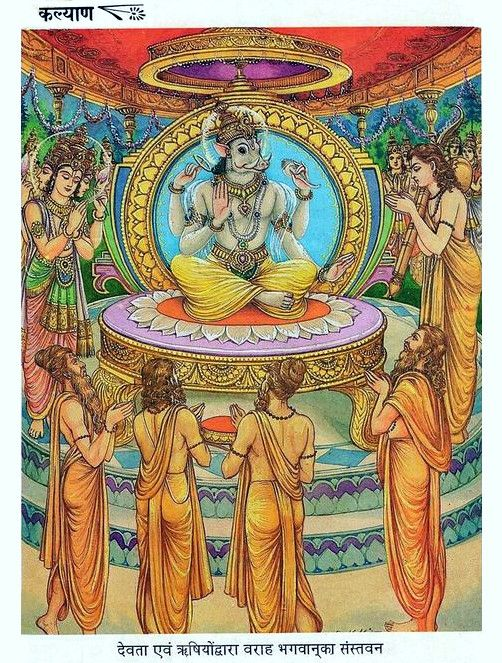
Vahara worshiped by the devas and great sages.
Though people in the modern world may take such accounts as something akin to fairy-tales, the above narrations from the Puranas provide us with not only information about the vast tracts of land beyond our own small area of the Earth, they also awaken the sleeping soul from the stupor of delusion by opening a window to the transcendental reality. The events of 2020-21 are like the unfolding of some sort of surreal black comedy, wherein all the people in the world—who have been first duped into believing that they stand in the same upright position even whilst standing on opposite sides of a spherical surface (the globe)—have been left unable to tell 'up' from 'down', 'right' from 'wrong', and 'reality' from 'illusion', and have thus stealthily come under the control of a gang of masked dacoits posing as political leaders. You couldn't make it up! According to the Puranas we actually are on the plane of the great flat-Earth that is presided over by Sri Sri Bhu-Varaha, and whilst the rest of the Bhu-mandala goes on with its worship of Sri Vishnu, those who fall for maya's great deception are given over to the satanic government of Kali-yuga.

In a chapter of Srimad Bhagavatam called the Bhumi-gita (Song of the Earth) we hear the following speech from Bhumi-devi:
"Sukadeva Gosvami said: Seeing the kings of this Earth busy trying to conquer her, the Earth herself laughed. She said: "Just see how these kings, who are actually playthings in the hands of death, are desiring to conquer me. Great rulers of men, even those who are learned, meet frustration and failure because of material lust. Driven by lust, these kings place great hope and faith in the dead lump of flesh called the body, even though the material frame is as fleeting as bubbles of foam on water. Kings and politicians imagine: 'First I will conquer my senses and mind; then I will subdue my chief ministers and rid myself of the thorn-pricks of my advisors, citizens, friends and relatives, as well as the keepers of my elephants. In this way I will gradually conquer the entire Earth.' Because the hearts of these leaders are bound by great expectations, they fail to see death waiting nearby. After conquering all the land on my surface, these proud kings forcibly enter the ocean to conquer the sea itself. What is the use of their self-control, which is aimed at political exploitation? The actual goal of self-control is spiritual liberation." O best of the Kurus, the earth continued as follows: "Although in the past great men and their descendants have left me, departing from this world in the same helpless way they came into it, even today foolish men are trying to conquer me." (SB 12.3.1-6)
AMBA (MOTHER)
Srimad Bhagavatam informs us that as Lord Varaha lifted the Earth, the sages spoke the following words addressing the Earth as mother (mata):
"O Lord, for the residential purposes of all inhabitants, both moving and non-moving, this Earth is Your wife (patnim), and You are the supreme father (pitaa). We offer our respectful obeisances unto You, along with mother Earth (mataram), in whom You have invested Your own potency, just as an expert sacrificer puts fire in the arani wood." (SB 3.13.42)
Here it says that Bhumi is the mother (mataram) and Vishnu is the father (pitaa) of all beings. The Brahma-vivarta Purana explains that the Earth is ultimately an expansion of Sri Radha, whilst Ananta-sesha who holds and supports the Earth is an expansion of Sri Krishna. Sri Krishna said to Radha, aham seshas ca kalaya svamsena tvam vasundhara:
"As a potter cannot create a pot without clay, so I cannot create the worlds without You. I expand as Lord Sesha and You expand as the Earth, the resting place of crops and jewels. Then I carry You, the Earth, on My head. O beautiful one, You are beauty, peace, form, gracefulness, saintliness" (Brahma-vivarta Purana, Krishna Janma Khanda, Chapter 67, Verses 76-77)
In Srimad Bhagavatam, the devas also call Bhumi mother (amba):
""O mother Earth [amba], the Supreme Personality of Godhead, Hari, incarnated Himself as Lord Sri Krishna just to unload your heavy burden. All His activities here are transcendental, and they cement the path of liberation. You are now bereft of His presence. You are probably now thinking of those activities and feeling sorry in their absence." (SB 1.16.23)
Through-out Srimad Bhagavatam, the goddess of the Earth appears in the pastimes of Krishna. For example, in the following scene, Bhumi presents Lord Krishna with various items that had been stolen by her son Bhaumasura:
"The goddess of the Earth then approached Lord Krishna and presented Him with Aditi's earrings, which were made of glowing gold inlaid with shining jewels. She also gave Him a Vaijayanti flower garland, Varuna's umbrella and the peak of Mandara Mountain. O King, after bowing down to Him and then standing with joined palms, the goddess, her mind filled with devotion, began to praise the Lord of the universe, whom the best of demigods worship". (SB 10.59.23-24)
The gopis praise the good fortune of the Earth in this way:
"O Mother Earth, what austerity did you perform to attain the touch of Lord Keshava's lotus feet, which has brought you such great joy that your bodily hairs are standing on end? You appear very beautiful in this condition. Was it during the Lord's current appearance that you acquired this ecstatic symptom, or was it perhaps much earlier, when He stepped upon you in His form of the dwarf Vamanadeva, or even earlier, when He embraced you in His form of the boar Varahadeva?" (SB 10.30.10)
In this exquisite verse, we get an understanding of how Bhumi's consciousness pervades the physical landscape of the Earth: as Sri Krishna touches the Earth with his lotus feet, Bhu-devi simultaneously experiences various ecstatic symptoms such as the hairs on her body standing on end. Here we can understand the non-difference between the physical and spiritual form of the Goddess. Since the Earth is an emanation of Sri Krishna's energy, the Earth is ultimately to be understood as spiritual energy. The point is explained by Srila Prabhupada in the following discussion:
Dr. Singh: Is material consciousness the absence of Krishna consciousness?
Srila Prabhupada: Yes.
Dr. Singh: And when there is Krishna consciousness, where is material nature?
Srila Prabhupada: If you continue in Krishna consciousness, you will see that nothing is material. When you offer a flower to Krishna, it is not material. Krishna will not accept anything material. And this does not mean that the flower is material on the bush, and then it becomes spiritual when you offer it to Krishna. No. The flower is "material" only as long as you think that it is made for your enjoyment. But as soon as you see that it is for Krishna's enjoyment, you see it as it really is—spiritual.
Dr. Singh: So the entire world is actually spiritual?
Srila Prabhupada: Yes. Therefore, we want to engage everything in Krishna's service; that is the spiritual world.
(Life Comes From Life, The Tenth Morning Walk, May 14, 1973)
In another place Srila Prabhupada states:
"Actually, there is nothing except Krishna and His energies. As Narada Muni says, idam hi visvam bhagavan ivetarah: "This world is Krishna, Bhagavan." But to those in ignorance it appears different from Bhagavan. For a maha-bhagavata, a pure devotee, there is no conception of material and spiritual, because he sees Krishna everywhere." (The Journey of Self Discovery, 3.3, Krishna the Enchanter of the Soul)
Bhumi is herself conscious of the activities of all the living entities who reside on the Earth as expressed in the following verse:
"There is nothing more sinful than untruthfulness. Because of this, Mother Earth once said, "I can bear any heavy thing except a person who is a liar." (SB 8.20.4)
We can begin to appreciate the spiritual nature of the Earth by recognizing and acknowledging the conscious, sentient, and personal nature of Bhumi herself; and also by giving constant thanks for her bountiful supply. The Vedas provide beautiful hymns in praise of the Earth such as the Bhumi-sukta. Srila Prabhupada would often refer affectionately to ‘Mother Earth’ in his lectures:
"The Earth is supplying food to everyone. As the mother gives life or maintains the child by the milk of her breast, similarly, the Earth mother is maintaining all different types of living entities. There are 8,400,000 different forms of life, and the Earth, Mother Earth is supplying food." (Ratha Yatra Festival, New York July 18, 1976)
Srila Prabhupada would often lecture on the respect that is due to the seven mothers which includes one’s own mother, the Earth, the cow, etc.
CHARACTERISTIC FEATURES OF THE EARTH GODDESS
In the Vishnudhamottara Purana, the instructions for painting a form of the Earth Goddess are given as follows:
"Markandeya said: The Earth-goddess (Mahi) should be made of the colour of the parrot, adorned with divine ornaments, with four hands, as a placid person and with her garment as white as the moonlight. Oh delighter of the Yadavas, in the hand of Bhu (Earth goddess) should be held a jewel-vessel, a corn-vessel, a vessel full of medicinal plants and a lotus. She should be rendered seated on the back of the four elephants of the quarters. Accompanied by all vegetable life, the goddess is traditionally said to be of bright colour. Her white garment is religion (dharma), and the lotus in the hand is wealth (artha). The significance of the rest is known to the wise and so it may be taken as described to you by me to-day, oh king." (Vishnudharmottara, Part III, Ch. 61, Verses 1-5, translated by Stella Kramrisch, Calcutta University Press 1928)
In the Vedic pantheon of gods and goddesses, each is recognize by certain symbols, vehicles, etc. Here it is stated that a painting of Bhumi-devi should show the symbols of jewels, corn, medicinal plants, and a lotus. Bhumi has a fantastic bright colour like the parrot (or Durva grass as mentioned in the above cited verse from Padma Purana). In contrast to the impersonalistic and highly disturbed nature of modern art genres such as Abstract Expressionism, Vedic art is a fountain of transcendental personalism, form, truth, beauty, peace, and charm. The Vishnudharmottara is an extraordinary treatise on the art of transcendence.
EARTH IN THE AGE OF IMPERSONALISM
Whilst people may continue to speak in a sentimental manner about ‘Mother Earth’, the idea that there is actually a divine conscious personality known as Bhumi with a name, form, abode, servants, pastimes, etc. has been almost entirely lost. In the so-called ‘scientific’ age when the Earth is no longer understood or respected as the physical manifestation of Goddess Bhumi, is it any surprise that the Earth itself has been exploited and trashed in such an ignorant, offensive, and impersonal manner? If we look closely at the scene of horror pictured below, we can just about make out the form of a young girl scavenging amidst the rubbish heap. The sankirtan movement has been inaugurated to bring an end to such misfortune.
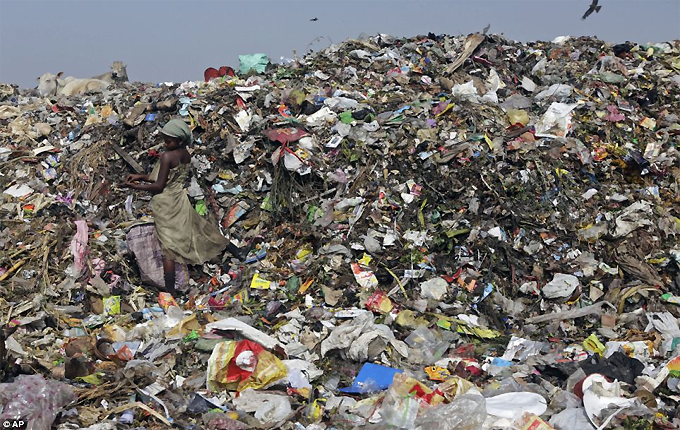
In the age of atheistic materialism and impersonalism it is, of course, very difficult for people to accept the Srimad Bhagavatam’s teaching that the Earth has a personified form, a place of residence etc.; but even for those who can accept that the Earth is a sentient being, what percentage will be able to grasp the Srimad Bhagavatam’s teaching that the physical shape of the Earth is not that of a globe floating in space, but rather that of a gigantic circular disc held by Ananta-sesha? Members of ISKCON are not immune to the pernicious effects of impersonalism, indeed, one’s faith in the modern idea of the Earth as a globe floating in space, may unfortunately be a reason to doubt or outright reject the Srimad Bhagavatam’s description of the Earth. The danger here is that if one cannot believe the description of the Earth in chapters 16-20 of the Fifth Canto, what absolute faith can one exhibit in the pastimes of Sri Krishna, the Supreme Personality of Godhead who sports on the Earth therein described, or in the personality of Bhu-devi herself who is eternally engaged in the service of the Lord's lotus feet.
THE EARTH IN CLASSICAL INDIAN PAINTING
In classical Indian painting (right up until the end of the 19th century), we always find the Earth depicted as a flat-Earth (see images below). It is telling that until the 20th century the Earth is never depicted as having the form of a globe; moreover in the paintings of Varaha lifting the Earth we will always see the Earth Goddess seated upon the Earth either in the form of a beautiful Goddess or in the form of a cow. The images below depicting Goddess Bhumi are not only charming and delightful; they also inspire devotion and faith being based on the Vedic understanding that we live in a personal and conscious universe. We will also draw attention to the fact that in most of the paintings, images of temples are scattered over the landscape of the Earth. The depictions of the cow and the temple reveal the obvious piety of the people who considered cows and temples as the most important thing on the Earth’s landscape. This is a far cry from our modern materialistic world which is covered in skyscraper buildings, and places were innocent animals are killed and consumed. Is there a connection between the rise of the globe ideology, and the ensuing environmental exploitation, pollution, and destruction?
The following selections of paintings from the period of 1640 to 1890 all show the Earth as a flat circular plane, not a globe. In later parts of this paper we shall show that paintings of Varaha holding a globe are an invention of the 20th century and follow an intense period of indoctrination into the non-Vedic cosmological world-view propagated by the British Imperialists during the period of their rule in India, particularly during the 19th century.
BHU-VARAHA PAINTINGS FROM THE 1600’s (17th CENTURY)
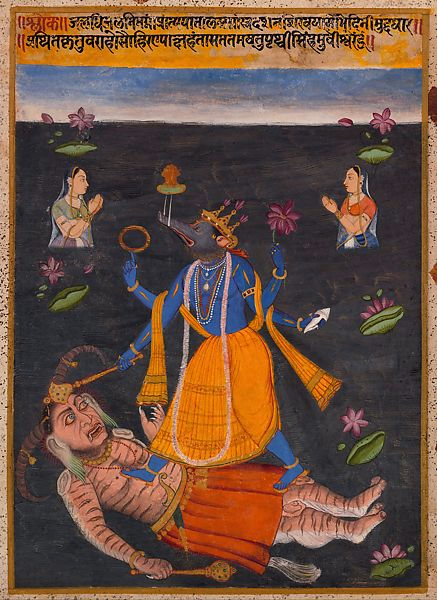
Varaha, the Boar Incarnation of Vishnu, Saves the Earth
Illustrated folio from a dispersed Vishnu Avatara (The Incarnations of Vishnu) circa 1650, Bikaner, Rajasthan
New York Metropolitan Museum
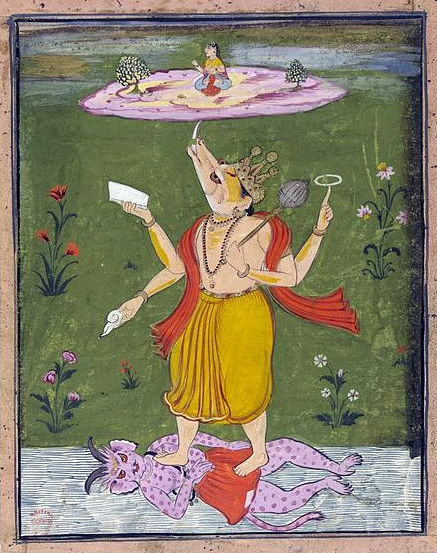
Varaha 17th Century (late)
In the above scene we see Bhumi in her personified form sitting on the flat-Earth. The above painting is from a collection at the British Museum.
BHU-VARAHA PAINTINGS FROM THE 1700’S (18TH CENTURY)
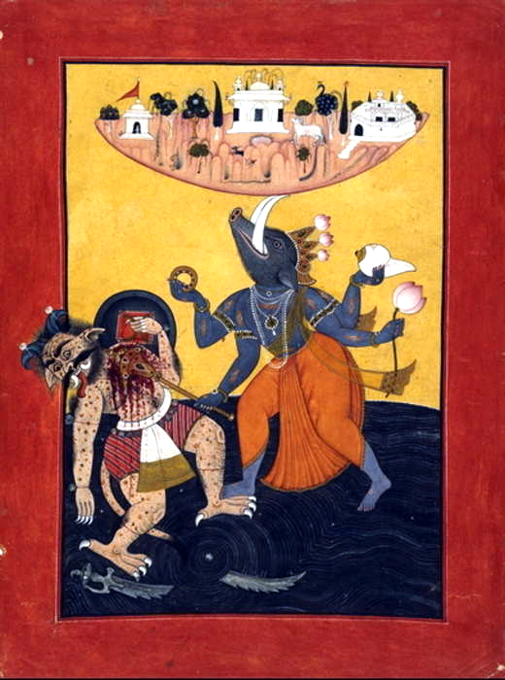
Varaha 1700-1710, Pahari school, Punjab, India. The above painting is part of the British Museum collection.
THE FLAT-EARTH, THE GODDESS, THE COW, THE TEMPLE, AND THE OCEAN AT THE BOTTOM OF THE UNIVERSE
In these first few paintings we see some of the classic images that are repeated through-out the centuries, namely (1) the Earth depicted as a flat-Earth; (2) the cow which can be taken to represent either the Goddess of the Earth who often takes the form of a cow, or simply as a representative of the cows who are very dear to Sri Govinda, and thus animals that are always to be protected. Just as Varaha killed the demon Hiranyaksha and made the Earth (gam) safe and secure, so the cow (also named gam) is depicted grazing safely and peacefully upon the land; (3) another important feature in most of the paintings of Varaha is the presence of the temple on the surface of the Earth. The depiction of the temple indicates that spiritual culture was of central importance to the Aryan people; (4) we also see Varaha rising from the water, indicating that there is a great ocean of water below the Earth; it is not that the Earth is surrounded with infinite dark space as modern images of the Earth globe portray (we shall discuss this detail later); (5) all of the paintings portray the destruction of evil represented by the death of the demon Hiranyaksha at the hands of Varaha. In the image below we see the dead body of the demon Hiranyaksha under the lotus feet of Varahadeva.

Illustration of Varaha Avatar of Vishnu, Bikaner, circa 1720
In the above painting we see Varaha once again lifting the flat-Earth with the cow sitting peacefully on the surface. Below the Earth is the Garbhodaka Ocean which fills the bottom part of the universe. The painting can be seen at the website for Saffron Art.
(To be continued...)

| The Sun |
News |
Editorials |
Features |
Sun Blogs |
Classifieds |
Events |
Recipes |
PodCasts |
| About |
Submit an Article |
Contact Us |
Advertise |
HareKrsna.com |
Copyright 2005, 2021, HareKrsna.com. All rights reserved.
|
|








